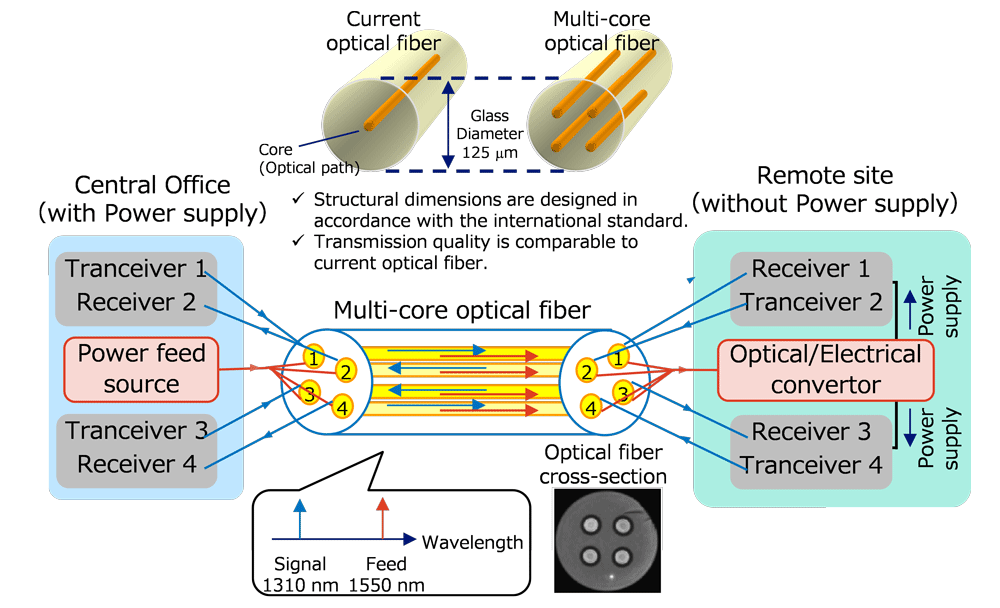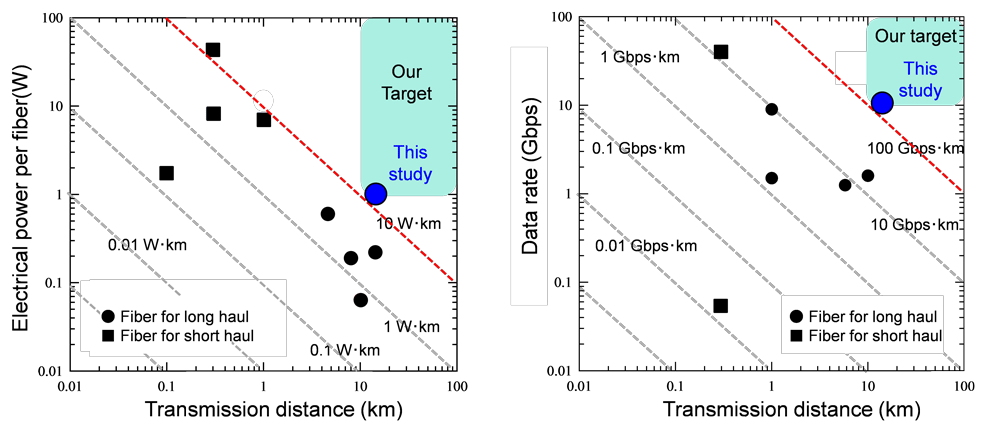Microsoft ends support for Internet Explorer on June 16, 2022.
We recommend using one of the browsers listed below.
- Microsoft Edge(Latest version)
- Mozilla Firefox(Latest version)
- Google Chrome(Latest version)
- Apple Safari(Latest version)
Please contact your browser provider for download and installation instructions.
August 29, 2023
Nippon Telegraph and Telephone Corporation
Kitami Institute of Technology
World's Highest Power over Fiber Transmission: Connect with non-electrified areas over 10 km away via optical fiber
Nippon Telegraph and Telephone Corporation (NTT, Chiyoda-ku, Tokyo; President and CEO: Akira Shimada) and Kitami Institute of Technology (Kitami, Hokkaido; President: Soichiro Suzuki) have succeeded for the first time in the world in supplying more than 1 W of electrical power to a point without power supply more than 10 km away using one single-mode optical fiber, while maintaining high communication speed and quality. This achievement is expected to enable the provision of high-speed optical communication to arbitral areas where optical communication is not provided, including areas without a power supply, and to establish emergency optical communication in the event of a disaster when the power supply is lost.
This remarkable research was accepted for presentation at the world's largest international conference on optical communication technology (the 49th European Conference on Optical Communications (ECOC), to be held in Glasgow, Scotland), where it will be delivered on October 4, 2023.
[Research Background]
With the progress of optical communication and wireless access technologies, high-speed data communication is now available everywhere in our daily lives. On the other hand, in the non-electrified area, it has been difficult to establish a wireless base station and/or optical access point. In recent years, large-scale earthquakes and typhoons have frequently caused widespread and prolonged power outages, resulting in serious situations that require time for restoration. In the event of a disaster, it is important to quickly restore communication with the affected area.
For early restoration of communications in emergency situations, research is being conducted on technologies that can achieve optical communication with remote non-electrified areas by propagating optical signals for communication and power supply over optical fibers, namely, power over fiber (PoF) transmission. However, with conventional technology, it is impossible to supply electrical power to locations more than 10 km away due to the optical input power limit of optical fibers*1. NTT has been conducting research and development of multi-core optical fiber (MCF*2), one of the key technologies to realize the IOWN*3 high-capacity optical communication infrastructure, and investigated optical power feeding and transmission using MCF.
[Features of Achievements]
1. Multi-core optical fiber (MCF)
Figure 1 shows a schematic diagram of our proposed PoF system using MCF. The MCF has the same glass diameter as that of current optical fibers and each core has transmission characteristics equivalent to those of current optical fibers, so it can be used in combination with existing transmission equipment for ordinary optical communications. In addition, since each core can be used independently (without optical signal interference between cores), any given core can be allocated for either power feeding or communication, or both.
In this study, we used four cores for the optical power feeding to maximize the output power. A power feeding wavelength was set at 1550 nm. Furthermore, we used two of the four cores and assigned an uplink and downlink signal of 1310 nm to each core to achieve bi-directional optical communication. Two sets of bi-directional optical links can also be configured.
 Figure 1 Schematic diagram of power feeding system utilizing multi-core optical fiber.
Figure 1 Schematic diagram of power feeding system utilizing multi-core optical fiber.
2. World's highest PoF transmission capability
Optical power feeding capability can be expressed as the electrical feeding power and transmission distance multiplicity factor. In this study, we achieved a highest 1 W × 14.1 km (14.1 W・km) using the MCF and managing the undesired return light in the system, which reduces the output optical power (see Figure 2 left).
In addition, we demonstrated a self-powered bi-directional optical communication system with a data rate of 10 Gbps. 10 Gbps is the fastest data rate that has been commonly used for a personal optical communication user. In this study, we investigated a two-core uplink/downlink system configuration and confirmed good transmission characteristics after a 14.1 km transmission. Considering the multiplicity factor of the data rate and transmission distance as an index of transmission performance in self-optical feeding transmission, the world's highest transmission performance of 140 Gbit/s・km was achieved (see Figure 2 right).
 Figure 2 Relationship between electrical power and transmission distance (left) and transmission data rate and distance for the simultaneous transmission experiments of data and feed light (right) using a single optical fiber.
Figure 2 Relationship between electrical power and transmission distance (left) and transmission data rate and distance for the simultaneous transmission experiments of data and feed light (right) using a single optical fiber.
[Future Prospects]
The present achievement has demonstrated that MCF, which has the same characteristics as currently used optical fiber, can be utilized for both usual optical communications and PoF-based optical communications. This improves the network resilience in times of disaster or emergency by sending power feeding light from a central office to areas where power supply is lost. In the future, it is expected that optical communications can be provided to non-electrified and hard-to-electrify area even during normal times. Our proposed technology also contributes to realize a sensing network by linking a variety of IoT devices. We will continue to promote research and development through industry-academia collaboration to further improve the optical power feeding performance.
[Glossary]
*1Optical input power limit of optical fibers
The output optical power of an optical fiber is proportional to the input optical power, but when the input light exceeds a certain threshold intensity, the output optical power saturates due to the phenomenon of *transmission distance of the optical fiber increases and as the core of the optical fiber becomes smaller. For this reason, it has been difficult to transmit optical signals of higher power over longer distances using optical fibers with small cores, which are suitable for high-speed optical transmission.
*2Example of research and development of multi-core optical fiber (MCF)
https://group.ntt/en/newsrelease/2017/08/08/170808b.html
*3IOWN (Innovative Optical and Wireless Network) concept
https://www.rd.ntt/e/iown/index.html
Media Contact
NTT Information Network Laboratory Group
Planning Department, Public Relations Section
nttrd-pr@ml.ntt.com
Kitami Institute of Technology
Public relations strategy unit
soumu05@desk.kitami-it.ac.jp
Information is current as of the date of issue of the individual press release.
Please be advised that information may be outdated after that point.
NTT STORY
WEB media that thinks about the future with NTT










